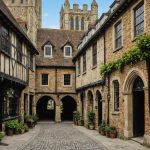Overview of British Press Heritage Tours
The British press heritage offers a fascinating glimpse into the history and evolution of journalism. This heritage is significant not only for its historical value but also for its contribution to shaping contemporary journalism practices. For enthusiasts eager to explore this rich history, a variety of historical tours are available, providing a unique opportunity to engage with the past. These tours are designed to be immersive, allowing participants to delve deep into the narratives that define British journalism.
There are several types of journalism exploration tours to choose from. Some focus on specific periods or events, while others provide a comprehensive overview of the development of the press in the UK. Tour-goers can expect to visit key locations integral to the history of the British press. These locations, rich in historical narratives, reveal the stories behind some of the country’s most influential publications. Visitors will also learn about the key figures who played pivotal roles in the evolution of journalism.
Have you seen this : Uncover Authentic British Carpentry Skills: In-Depth Workshops for Curious Tourists
In summary, exploring the British press heritage through these tours offers an engaging way to understand the past’s influence on modern journalism. Such ventures provide invaluable insights into the enduring legacy of British journalism.
Highlights of Key Locations
Embarking on a journey through notable press locations unveils the historical significance of key press heritage sites. These locations, each with unique narratives, provide a fascinating look into the development of journalism in the UK.
In parallel : Discovering Staffordshire’s Ceramics: An Immersive Tourist Guide to Historic Pottery Workshops in Britain
London: The Heart of British Journalism
London has long been a powerhouse in the world of journalism. Home to iconic publications like “The Times” and “The Guardian,” its streets echo the footsteps of revolutionary editors and writers who have shaped public discourse. Fleet Street, once the epicenter of British journalism, stands as a testament to the city’s rich press history.
Edinburgh: The Birthplace of Modern Journalism
Edinburgh’s contribution to modern journalism is remarkable. This city gave rise to pivotal journalism practices that transformed press methodology. The Scotsman, founded here, has been a significant voice in political and cultural discourse, cementing Edinburgh’s place in journalistic history.
Manchester: The Industrial Revolution and the Press
Manchester played a crucial role during the Industrial Revolution, with journalism acting as a mirror to societal changes. Publications like “The Manchester Guardian” (now “The Guardian”) emerged, documenting industrial impacts and shaping social consciousness. Sites such as the People’s History Museum highlight these transformative narratives.
Impact of the British Press
The role of press in history has been pivotal in influencing British society, serving as both a mirror and molder of public opinion. This unique power emerged from the way British journalism tackled key historical events, bringing stories that otherwise might have been overlooked to the forefront.
Notable publications such as “The Times” and “The Guardian” have not only informed but significantly impacted public opinion through their investigative journalism and thought-provoking editorials. For instance, “The Guardian” played a critical role during the Industrial Revolution, enlightening the masses about societal changes. The British press’s impact is evident in its capacity to shape discourse and instigate change by holding power to account.
British journalism’s influence extends to pivotal historical moments, including the abolition of slavery and universal suffrage. Press coverage during these times helped to unleash societal changes by stirring public support and debate.
Exploring the notable publications and their contributions during heritage tours affords enthusiasts an understanding of how journalism not only reported on events but actively engaged in crafting history itself. Understanding this interplay between press and society underscores the enduring significance of the British press.
User Testimonials and Experiences
Exploring British press heritage is an unforgettable journey, enriched by customer reviews and tour experiences from fellow enthusiasts. Participants often describe the tours as enlightening, emphasizing how these experiences illuminate the intricate tapestry of British history. One common theme is the tours’ role in fostering a deeper understanding of journalism’s impact on societal changes.
Enthusiast feedback often highlights the tours’ exceptional ability to introduce visitors to key historical narratives and figures that shaped journalism. Tour-goers praise the immersive quality, recounting stories of stepping back into pivotal moments in press history. The enthusiasm shared by others can spark an eagerness in new visitors to dive into this enlightening experience.
Specific aspects often receive positive feedback, particularly the knowledgeable guides who enhance the experience with their insights. Enthusiasts consistently mention the depth of knowledge provided by these guides, which adds richness to the exploration. Beyond history enthusiasts, journalists and scholars also find the insights gained from these tours invaluable.
Engaging in these tours reveals how deeply ingrained journalism is in the fabric of British history, making them a worthwhile venture for anyone interested in understanding the press’s historic influence.
Pricing and Scheduling Information
For those interested in exploring the British press heritage, understanding the tour costs and scheduling options is crucial for planning a visit. Typically, the pricing structure varies based on the type of tour, with private tours commanding a higher price due to the personalized experience they offer. Many tours also provide group rates, making it an affordable option for educational institutions or drama clubs looking to explore history collectively.
Seasonal scheduling ensures that tours are available throughout the year, although high-demand seasons such as summer might require early bookings. The flexibility in timing allows participants to choose tours that fit their schedules. Group bookings often receive discounts, providing a cost-effective way for larger parties to enjoy the experience together.
For those keen on deepening their engagement with the tours, there’s an option to combine different types of tours, exploring both notable press locations and impactful historical narratives. This combines cost savings and a richer, more comprehensive perspective on British journalism. Opting for tours that offer group rates and early bookings can make the experience accessible and enriching for all interested in the storied past of British journalism.
Enhancing the Touring Experience
Experiencing the British press heritage tours is greatly enriched by incorporating visual aids, maps, and various interactive elements. These components ensure that participants gain a comprehensive and immersive understanding of the history of journalism in the UK.
Use of Engaging Visuals
Visuals play a critical role in bringing historical narratives to life. Through pictures, videos, and even virtual reality, visitors can grasp the evolution of journalism. Engaging visuals help illuminate the nuanced details of the past, making the narratives accessible and memorable. They also serve to depict the vibrancy of the press heritage sites.
Incorporating Maps for Navigation
Maps are essential tools for navigating the breadth of historical tours. They efficiently guide participants through key locations, ensuring a seamless experience without missing any notable sites. Customised tour maps highlight notable press locations, providing context to each stop for a more informed exploration.
Interactive Components of Tours
Adding interactive components significantly enhances the touring experience. Visitors can engage with archives, listen to reenactments of historic events, or partake in simulated editorial activities. Each element offers an active way for participants to connect deeply with the rich heritage they explore. This interactive approach not only enhances understanding but invigorates curiosity and engagement.
Notable Figures in British Journalism
The British press has been shaped by numerous influential journalists over the years. These historical figures have left indelible marks on journalism and society, establishing themselves as true press pioneers. During historical tours, participants are introduced to these key figures’ stories, integrating their contributions into a broader narrative of press evolution.
Profiles of Key Journalists
Names like William Cobbett, known for his bold critiques of societal issues, and Harold Evans, celebrated for his investigative journalism, are central to the tours. Their commitment to truth and reform has had long-standing effects on journalistic practices. Each tour dives into their personal journeys, illustrating how their relentless pursuit of justice and accountability resonated through British journalism.
These figures not only reported events but often influenced their outcomes, showcasing journalism’s power to shape public opinion. Participants can expect to learn about figures like Mary Ann Shadd Cary, an advocate for abolition and women’s rights, highlighting journalism as a catalyst for social change. The tours offer a vivid portrayal of these pioneers’ legacies, making them accessible and relatable to modern audiences.










